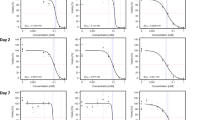Abstract
Primary cultured rat hepatocytes were used as an experimental model to detect adverse effects of five chlorophenols (CP) in vitro (penta-CP, 2,3,4,5,-tetra-CP, 2,4,5,-tri-CP, 2,4-di-CP, and 4-mono-CP). Monolayer cultures were exposed to the test compounds for 1 h, and concentration response curves were established with respect to the effects on phase I and phase II metabolism of 7-ethoxycoumarin (7-EC) and on cellular ATP content. All CP tested inhibited the O-dealkylation of 7-EC, with half-maximum effective concentrations (EC50) ranging from about 36 μM for the three highest chlorinated phenols to 215 μM for 4-mono-CP, which proved to be least effective. The subsequent conjugation of the primary metabolite 7-hydroxycoumarin was even more sensitive towards CP exposure than the O-deethylation process. The concentrations which reduced the percentage of conjugated metabolite to 50% of the respective control cultures ranged from 7 μM for penta-CP to 48 μM for 4-mono-CP. Treatment of cultured hepatocytes with CP additionally resulted in a depletion of cellular ATP at EC50 concentrations ranging from 6 μM for penta-CP to 1330 μM for 4-mono-CP. Cellular viability, as measured by the leakage of lactate dehydrogenase from the cells, was not affected by any of the CP within the 1-h exposure period.
Similar content being viewed by others
References
Ahlborg UG, Thunberg TM (1980) Chlorinated phenols: occurrence, toxicity, metabolism and environmental impact. CRC Crit Rev Toxicol 7: 1–35
Ahlborg UG, Larsson K, Thunberg TM (1978) Metabolism of pentachlorophenol in vivo and in vitro. Arch Toxicol 40: 45–53
Aitio A (1978) A simple and sensitive assay of 7-ethoxycoumarin deethylation. Anal Biochem 85: 488–491
Arrhenius E, Renberg L, Johansson L, Zetterquist MA (1977) Disturbance of microsomal detoxication mechanisms in liver by chlorophenol pesticides. Chem Biol Interact 18: 35–46
Babich H, Borenfreund E (1987a) Structure-activity relationship (SAR) models established in vitro with the neutral red cytotoxicity assay. Toxic in Vitro 1: 3–9
Babich H, Borenfreund E (1987b) In vitro cytotoxicity of organic pollutants to bluegill sunfish (BF-2) cells. Environ Res 42: 229–237
Bergmeyer HU, Bernt E (1974) Lactat-Dehydrogenase. In: Bergmeyer HU (ed) Methoden der enzymatischen Analyse, Vol 1. Verlag Chemie, Weinheim, pp 533–538
Braun WH, Young JD, Blau GE, Gehring PJ (1977) The pharmacokinetics and metabolism of pentachlorophenol in rats. Toxicol Appl Pharmacol 41: 395–406
Carlsson GP (1978) Effect of trichlorophenols on xenobiotic metabolism in the rat. Toxicology 11: 145–151
Cenci G, Caldini G, Morozzi G (1987) Chlorinated phenol toxicity by bacterial and biochemical tests. Bull Environ Contam Toxicol 38: 868–875
Edwards AM, Glistak ML, Luca CM, Wilson PA (1984) 7-Ethoxycoumarin deethylase activity as a convenient measure of liver drug metabolizing enzymes: regulation in cultured rat hepatocytes. Biochem Pharmacol 33: 1537–1546
Farquharson ME, Gage JC, Northover J (1958) The biological action of chlorophenols. Br J Pharmacol 13: 20–24
Fry JR, Bridges JW (1980) The metabolism of 7-ethoxycoumarin in primary maintenance cultures of adult rat hepatocytes. Naunyn-Schmiedeberg's Arch Pharmacol 311: 85–90
Götz R, Schwarz LR, Greim H (1980) Effect of pentachlorophenol and 2,4,6-trichlorophenol on the disposition of sulfobromophthalein and respiration of isolated liver cells. Arch Toxicol 44: 147–155
Kobayashi K, Kimura S, Shimizu E (1976) Studies on the metabolism of chlorophenols in fish — VII. Sulfate conjugation of phenol and PCP by fish livers. Bull Japan Soc Sci Fish 42: 171–177
Könemann H, Musch A (1981) Quantitative structure-activity relationships in fish toxicity studies. Part 2: The influence of pH on the QSAR of chlorophenols. Toxicology 19: 223–228
Koster H, Halsema I, Scholtens E, Knippers M, Mulder GJ (1981) Dose-dependent shifts in the saturation and glucuronidation of phenolic compounds in the rat in vivo and in isolated hepatocytes. Biochem Pharmacol 30: 2569–2575
Lilienblum W (1985) Formation of pentachlorophenol glucuronide in rat and human liver microsomes. Biochem Pharmacol 34: 893–894
Lowry OH, Rosebrough NJ, Farr AL, Randall RJ (1951) Protein measurement with the Folin phenol reagent. J Biol Chem 193: 265–275
Mulder GJ, Scholtens E (1977) Phenol sulphotransferase and uridine diphosphate glucuronyltransferase from rat liver in vivo and in vitro. 2,6-Dichloro-4-nitrophenol as selective inhibitor of sulphation. Biochem J 165: 553–559
Nendza M (1987) Toxizitätsbestimmungen von umweltrelevanten Chemikalien mit einem neuen Biotestsystem, Ermittlung physikochemischer Eigenschaften und Ableitung quantitativer Struktur-Toxizitäts-Beziehungen unter Anwendung von Multiregressions und Hauptkomponenten-Analyse. Thesis, University of Kiel
Palsson P (1981) Hochungesättigtes Phosphatidylcholin: Subzelluläre Kinetik in vitro und in vivo und Einfluß auf Induktion und Temperaturabhängigkeit der mikrosomalen Monooxygenase. Thesis, University of Kiel
Paterson P, Fry JR, Horner SA (1984) Influence of cytochrome P-450 type on the pattern of conjugation of 7-hydroxycoumarin generated from alkoxycoumarins. Xenobiotica 14: 849–859
Saarikoski J, Viluksela M (1982) Relation between physicochemical properties of phenols and their toxicity and accumulation in fish. Ecotoxicol Environ Safety 6: 501–512
Sato T, Suzuki T, Yoshikawa H (1953) Studies on conjugation of S35-sulfate with phenolic compounds. I. Experiments with liver slices. J Biochem 40: 663–671
Schultz TW, Riggin GW (1985) Predictive correlations for the toxicity of alkyl and halogen-substituted phenols. Toxicol Lett 25: 47–54
Schultz TW, Holcombe GW, Phipps GL (1986) Relationships of quantitative structure-activity to comparative toxicity of selected phenols in the Pimephales promelas and Tetrahymena pyriformis test systems. Ecotoxicol Environ Safety 12: 146–153
Seglen PO (1976) Preparation of isolated rat liver cells. In: Prescott DM (ed) Methods in cell biology, Vol 13. Academic Press, New York, pp 29–83
Weinbach EC (1954) The effect of pentachlorophenol on oxidative phosphorylation. J Biol Chem 210: 545–550
Weinbach EC, Garbus J (1965) The interaction of uncoupling phenols with mitochondria and with mitochondrial protein. J Biol Chem 240: 1811–1819
Wiebkin P, Parkin GL, Fry JR, Bridges JW (1979) Effect of various metabolic inhibitors on biphenyl metabolism in isolated rat hepatocytes. Biochem Pharmacol 28: 3315–3321
Author information
Authors and Affiliations
Rights and permissions
About this article
Cite this article
Aschmann, C., Stork, T. & Wassermann, O. Short-term effects of chlorophenols on the function and viability of primary cultured rat hepatocytes. Arch Toxicol 63, 121–126 (1989). https://doi.org/10.1007/BF00316433
Received:
Revised:
Accepted:
Issue Date:
DOI: https://doi.org/10.1007/BF00316433




